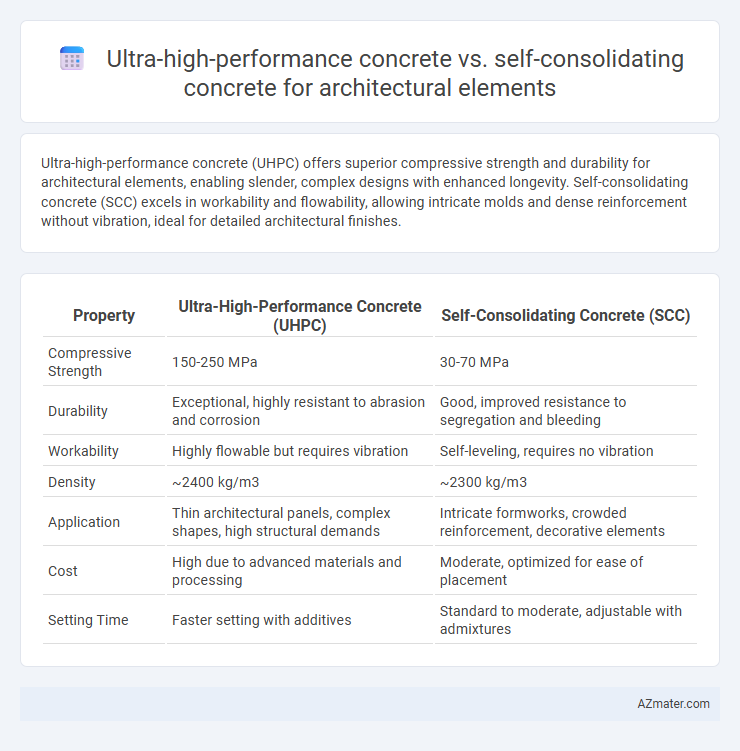Ultra-high-performance concrete (UHPC) offers superior compressive strength and durability for architectural elements, enabling slender, complex designs with enhanced longevity. Self-consolidating concrete (SCC) excels in workability and flowability, allowing intricate molds and dense reinforcement without vibration, ideal for detailed architectural finishes.
Table of Comparison
| Property | Ultra-High-Performance Concrete (UHPC) | Self-Consolidating Concrete (SCC) |
|---|---|---|
| Compressive Strength | 150-250 MPa | 30-70 MPa |
| Durability | Exceptional, highly resistant to abrasion and corrosion | Good, improved resistance to segregation and bleeding |
| Workability | Highly flowable but requires vibration | Self-leveling, requires no vibration |
| Density | ~2400 kg/m3 | ~2300 kg/m3 |
| Application | Thin architectural panels, complex shapes, high structural demands | Intricate formworks, crowded reinforcement, decorative elements |
| Cost | High due to advanced materials and processing | Moderate, optimized for ease of placement |
| Setting Time | Faster setting with additives | Standard to moderate, adjustable with admixtures |
Introduction: Comparing Ultra-High-Performance Concrete and Self-Consolidating Concrete
Ultra-high-performance concrete (UHPC) offers exceptional strength, durability, and permeability resistance, making it ideal for architectural elements requiring minimal maintenance and long-term resilience. Self-consolidating concrete (SCC) provides superior flowability and ease of placement without vibration, ensuring intricate forms and complex molds are reproduced with high precision. Both materials significantly impact architectural design, with UHPC emphasizing performance and longevity, while SCC prioritizes workability and surface finish quality.
Overview of Ultra-High-Performance Concrete (UHPC)
Ultra-High-Performance Concrete (UHPC) is a cutting-edge construction material characterized by exceptional compressive strengths exceeding 150 MPa and superior durability due to its dense microstructure and low permeability. Unlike traditional concrete, UHPC incorporates fine powders, fibers, and optimized particle packing, resulting in outstanding tensile strength and enhanced resistance to environmental degradation. Its capacity to create thin, complex architectural elements with high precision and long service life makes UHPC a preferred choice over Self-Consolidating Concrete (SCC) for innovative structural and aesthetic applications.
Key Properties of Self-Consolidating Concrete (SCC)
Self-consolidating concrete (SCC) exhibits exceptional flowability and segregation resistance, enabling it to fill complex architectural molds and intricate formworks without mechanical vibration. High viscosity and stability of SCC minimize voids and surface defects, ensuring superior surface finish and durability essential for architectural elements. Enhanced workability and uniform texture make SCC particularly advantageous for producing visually appealing, detailed components compared to ultra-high-performance concrete (UHPC).
Strength and Durability: UHPC vs SCC
Ultra-high-performance concrete (UHPC) exhibits superior strength, often exceeding 150 MPa, significantly outperforming self-consolidating concrete (SCC), which typically ranges between 30 and 50 MPa. The ultra-dense microstructure of UHPC enhances its durability, providing excellent resistance to chloride penetration, freeze-thaw cycles, and abrasion, making it ideal for demanding architectural elements. In contrast, SCC offers good durability due to its high flowability and uniform consolidation but generally lacks the advanced mechanical properties and longevity of UHPC in structural and exposed applications.
Workability and Placement Techniques
Ultra-high-performance concrete (UHPC) offers exceptional strength and durability for architectural elements but demands precise placement techniques due to its low workability and stiff consistency. Self-consolidating concrete (SCC) excels in workability with its high flowability and segregation resistance, simplifying placement and ensuring intricate form filling without mechanical vibration. Selecting between UHPC and SCC depends on balancing structural performance requirements with efficient, labor-saving placement methods tailored to complex architectural designs.
Surface Finish and Aesthetic Potential
Ultra-high-performance concrete (UHPC) offers superior surface finish with its dense matrix and fine particle distribution, producing ultra-smooth, high-gloss textures ideal for intricate architectural elements. Self-consolidating concrete (SCC) provides excellent flowability, enabling complex formworks to be filled without vibration, which ensures consistent surface quality and reduces imperfections such as air pockets and honeycombing. While UHPC excels in durability and intricate detail replication, SCC balances ease of placement and aesthetic versatility, making it suitable for nuanced surface textures and varied architectural finishes.
Architectural Applications and Design Flexibility
Ultra-high-performance concrete (UHPC) offers superior compressive strength and durability, making it ideal for intricate architectural elements requiring thin sections and long spans without compromising structural integrity. Self-consolidating concrete (SCC) enhances design flexibility by flowing easily into complex formworks and densely reinforced areas, ensuring high-quality surface finishes and reducing labor costs. Both materials support innovative architectural applications, with UHPC excelling in performance-driven projects and SCC enabling efficient construction of detailed and aesthetically refined components.
Cost Considerations and Material Availability
Ultra-high-performance concrete (UHPC) offers exceptional strength and durability for architectural elements but comes with higher material costs and limited availability due to specialized components like fine powders and steel fibers. Self-consolidating concrete (SCC) provides easier placement and reduced labor expenses, benefiting projects with complex formwork, although its material cost is generally lower and raw materials are widely accessible. Selecting between UHPC and SCC requires evaluating long-term performance value against immediate budget constraints and supply chain logistics for the specific architectural application.
Sustainability and Environmental Impact
Ultra-high-performance concrete (UHPC) demonstrates superior durability and reduced material usage, significantly lowering lifecycle carbon emissions compared to traditional concrete mixtures used in architectural elements. Self-consolidating concrete (SCC) enhances sustainability by minimizing waste and reducing the need for mechanical vibration, which lowers energy consumption and improves worker safety on-site. Both UHPC and SCC contribute to environmentally responsible construction, with UHPC offering longer service life and SCC promoting efficient placement and reduced resource depletion.
Choosing the Right Concrete for Architectural Elements
Ultra-high-performance concrete (UHPC) offers superior strength, durability, and enhanced aesthetic possibilities for intricate architectural elements, enabling thinner sections and longer spans with minimal maintenance. Self-consolidating concrete (SCC) excels in achieving smooth finishes and detailed formwork replication due to its high flowability and self-leveling properties, making it ideal for complex molds and dense reinforcement areas. Selecting between UHPC and SCC depends on structural demands, desired surface texture, and project scale, balancing cost-efficiency with performance requirements for optimal architectural outcomes.

Infographic: Ultra-high-performance concrete vs Self-consolidating concrete for Architectural element
 azmater.com
azmater.com